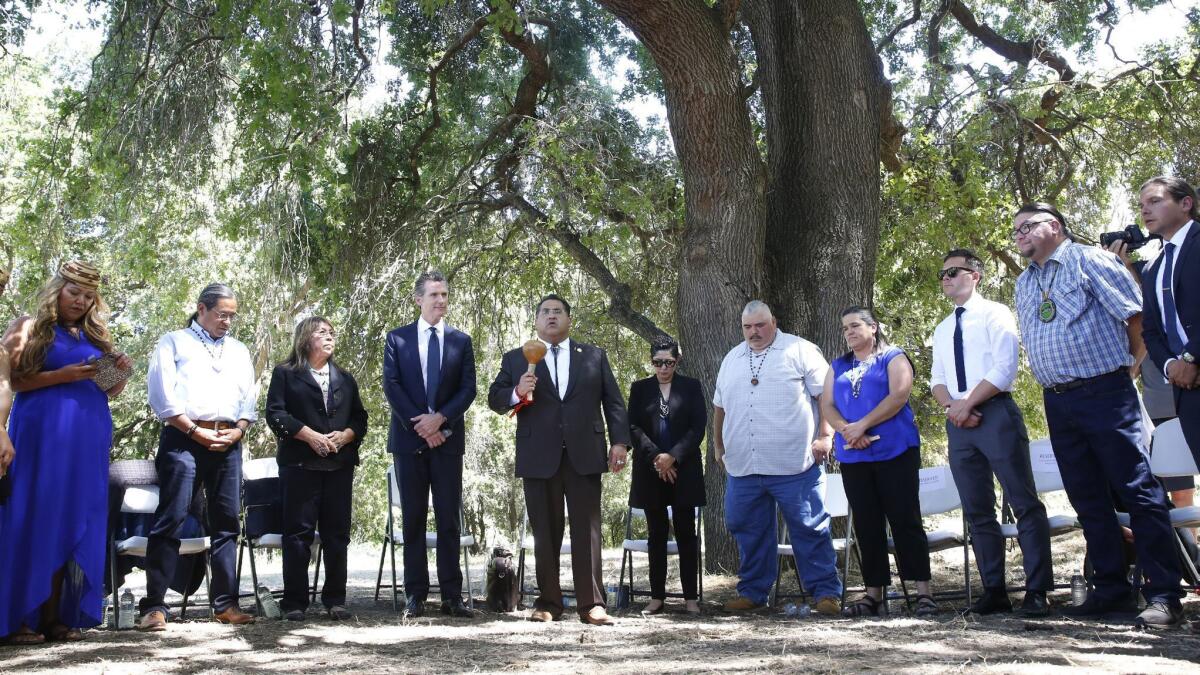Editorial:: California’s story was written with Native American blood. Let’s finally admit it

- Share via
In the Disney version of California, the Golden State was built by industrious settlers who came in waves from various points east to make their fortunes from the resource-rich land that, in some places, was actually lined in gold.
The truth, however, is somewhat darker, tinged as it is with the blood of thousands of indigenous people slaughtered to make way for the homes and farms and mines of white Americans. California became a U.S. state in 1850 and almost immediately launched campaigns — approved and abetted by state officials — against the state’s indigenous people, stripping them of the right to vote and of due process, legalizing indentured servitude and making it possible to remove them from their lands. The state paid militias to hunt down and kill Native Americans.
California’s first governor, Peter Burnett, declared in 1851 that “a war of extermination will continue to be waged ... until the Indian race becomes extinct.” Ben Madley, a scholar of Native American history at UCLA, calls it “genocide” and estimates that between 1846 and 1873, about 80% of the state’s Native Americans died from disease, starvation and murder.
On Tuesday, Gov. Gavin Newsom finally did what should have been done a long time ago.
California didn’t invent Indian removal and was certainly not the first state to facilitate the extermination of native people, but it carried on the tradition begun in the region by Spanish settlers decades earlier with shameful zeal. And like most such ignoble histories, it was largely hidden from the public in the years after government-sponsored mass murder fell out of favor. These days, California’s schoolchildren are still more likely to know about the Wounded Knee massacre in South Dakota than California’s Trail of Tears forced march in 1863.
Enter the Fray: First takes on the news of the minute »
On Tuesday, Gov. Gavin Newsom finally did what should have been done a long time ago. During a blessing ceremony at the site where the California Indian Heritage Center will be built, Newsom formally apologized for the state’s historical role in atrocities committed against thousands of native Californians. And it was more than a nice, if overdue, gesture: It was accompanied by the creation of a panel, which he called a Truth and Healing Council, that will hear testimony and seek to clarify the historical record. The council will also consider future steps, the governor said — which could include the possibility of formal reparations.
Assemblyman James Ramos (D-Highland), the state’s first Native American legislator, is right that the first step is to include this important, if brutal, part of the state’s history in California’s curriculum. That’s essential. Californians should know the full history of their state — not just the Gold Rush and the missions and the Progressive Era, but also the Yontocket massacre, in which white settlers wiped out a Tolowa village in Northern California in 1853. Whitewashing the past is unfair, dishonest and unhelpful.
Follow the Opinion section on Twitter @latimesopinion and Facebook
More to Read
A cure for the common opinion
Get thought-provoking perspectives with our weekly newsletter.
You may occasionally receive promotional content from the Los Angeles Times.










